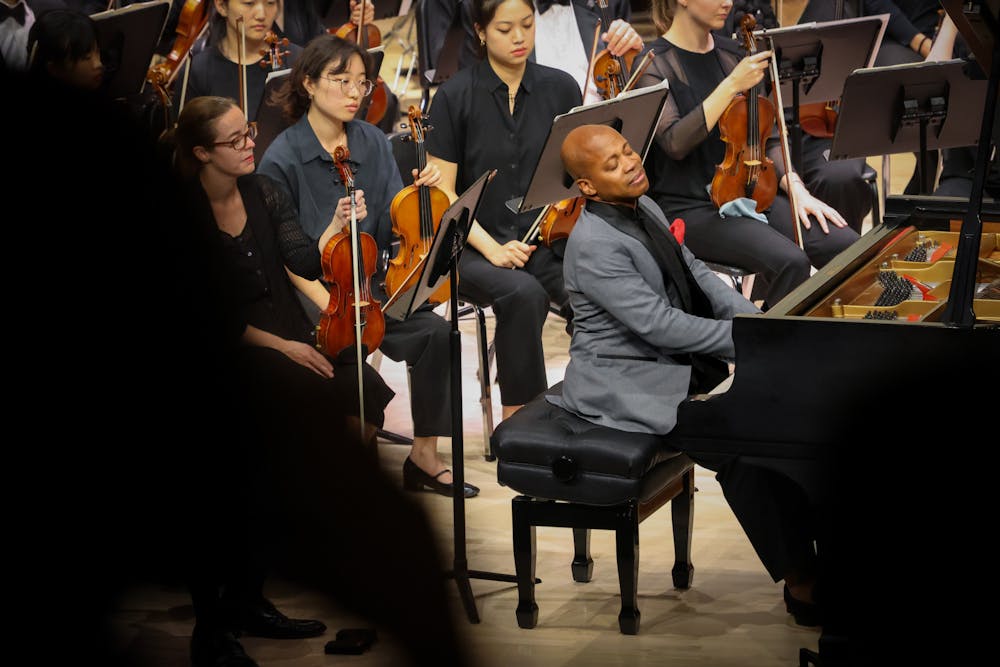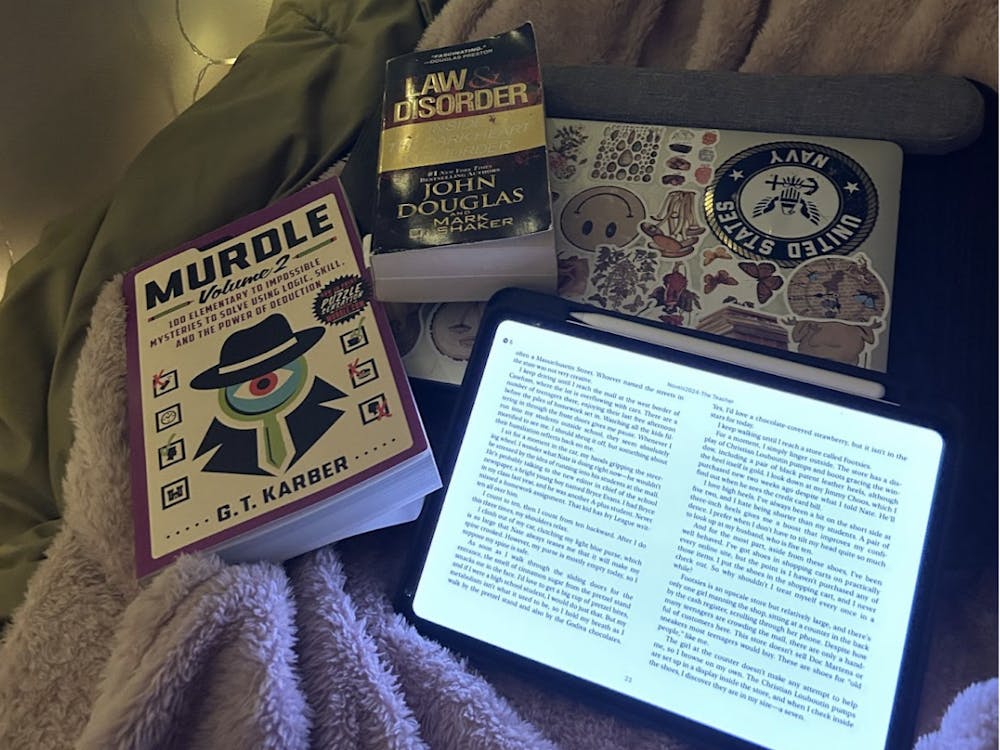The Hopkins Symphony Orchestra (HSO) delivered an expert performance on the evening of Oct. 5 in the Shriver Hall auditorium. The orchestra opened with William Grant Still’s Serenade before shifting to Maurice Ravel’s Piano Concerto in G Major and ending with Antonín Dvořák’s Symphony No. 9, or From the New World.
The auditorium seemed near capacity, filled with Hopkins students and community members alike. While the eagerly seated concert-goers maintained a respectful chatter before the concert, the auditorium fell silent when the concertmaster began his walk toward the inner circle. When he hit an A on the piano, no one dared say a word, listening to the group tune as if it was an extra piece added to the program last minute.

Music director Jed Gaylin provided a brief context for Still’s Serenade, but the piece spoke for itself. It began with a repeating, heaven-bound harp line backing the folksy yet elegant cello melody. The cellos passed the baton to the flute, which mediated the classicism of the harp’s part with the twang of the cello’s melody.
Then the serenade transitioned to a jumpy melody played by the flutes. Meanwhile, the strings supported the flutes with staccato eighth-note passages that boasted well-timed accents before they took the spotlight with an almost sinister melody — think of spy-movie, bank-heist themes. This was short lived, as the piece then mellowed out and returned to the folksy charm motif with which it began. Serenade concludes with an ascending flute part, slowing as it reaches the top, as if tired from climbing a tall set of stairs. The cellos get the final word with a two-part sigh: the breath in, a pause and the long exhale.
The next item in the program — Maurice Ravel’s Piano Concerto in G Major — was performed by pianist Terrence Wilson. The winsome performer’s toothy smile seemed to shine under the stage lighting, as did the unique glitter straps across his loafers. Then Ravel, himself, seemingly appeared to possess and transform Wilson, compelling his sparkling right foot to sourly stab the pedals of the piano as his free foot stomped the ground during especially intense passages. His shadow was thrown on the wooden floor of the stage for the audience to see as it jerked to and fro like a marionnette.

The first movement of the Ravel opened with a percussive slap and a militant yet jubilant, fast-paced flute line. Sitting in the higher register and reminding me of the many quick-moving legs of a centipede, the entire opening was colored anxious by the crawling piano part. Punctuated by bursts of light, staccato chords, the piece switched focus to a brooding, lyrical piano moment. This proliferated into a piano solo which featured flurries of chords, forcing Wilson to pound the keys, slightly lifting himself up from the plush piano bench with each strike.
This section sounded like a train going off the tracks yet not toward disaster. It reminded me of George Gershwin’s Rhapsody in Blue. After passing the train-like sound from section to section, the piece incorporated a religious theme for the piano, including a brief upward-reaching passage that was supported by melodic strings. Keeping the audience awake, this bliss was short-lived before the piano lurched to the lowest register, then crawled up the keys and ended with the familiar joyously militant march of the beginning. The audience couldn’t help but clap, ignoring the common etiquette of holding applause between movements.

The auditorium that was just filled with applause suddenly assumed an achingly tender mood as the tragic second movement began. Every good musician is an equally skilled actor: Wilson, empathizing with Ravel’s melody, melodramatically looked toward the ceiling with his brow furrowed and open mouth quivering. The orchestra sat in a morose silence, as if attending a funeral.
Shedding this sadness, the piece then established a conflicted, exposed section: a briefly sinister piano part composed of 16th notes, which then opened up into an uncertain — not joyous, not sad — passage where Wilson played 32nd notes that meandered up and down the keys, resembling raindrops. This was backed by a bittersweet melody for the English horn. The horn trilled up to a resolution for this melancholy, and the flute carried the piece forward to a saccharine ending, the piano ending on a quiet trill.

Like the first movement of the concerto, the third movement was brass-heavy, which was a welcome change from the second movement. The third movement also composed its instrumentation in quick clips, giving the feeling of numerous moving parts and a general sense of boiling and bustling. For all of the panic of the third movement, and the nuance of the prior two, the Concerto came to an abrupt and simple end: a resolute, two-part bang from the percussion.
To many in the audience, this sudden ending may have come as a shock. In a post-concert discussion with Jed Gaylin, HSO’s music director, as well as the soloist Wilson, one audience member inquired about the reason behind the concerto’s ending. Gaylin provided his insight on why Ravel may have written it as such.
“I don’t think [Ravel] ever calls attention to what he’s doing. It’s always that French thing of, ‘If you touch it, you kill it,’” Gaylin informs. “It’s over before you know it, and I think that’s part of the charm of the piece, actually.”

The program then moved to the flagship piece of the evening: Dvořák’s New World Symphony. As director Jed Gaylin explained, this symphony aimed to establish a formal example of American national music, taking inspiration from music like “Swing Low, Sweet Chariot,” memorializing African-American influence in the United States. From the first few phrases, I recognized Dvořák’s intent to establish an American tradition of music as a success.
The first movement, the Adagio–Allegro Molto, was a brooding, reflective section that instantly turned into an explosive and pompous show of force. Later, the flute led the movement toward a new light: with an exposed, almost self-conscious melody, it introduced a folksy motif that was quickly adopted by the rest of the orchestra. For the rest of the first movement, the orchestra balanced boisterous passages with derivatives of that same motif initially introduced by the flute.
The second movement of the piece, the largo, began with a brass swell that led up to a vulnerable English horn solo, which was hopeful yet reserved. This solo was expanded upon for half of the movement, alternating between the English horn and the rest of the orchestra until the flute and oboe steered the group toward a more mysterious sound, including more active and moving parts. The movement returned to its beginning with an ending that repeated the brass’s initial swell and — rather than leading to an English horn solo — concluded with ascending lines for the strings and woodwinds.

Dvořák’s New World Symphony is a prime example of contrast. Freshman Christopher Amanat remarked in an interview with The News-Letter after the concert that this detail is what made the symphony stand out among the night’s repertoire.
“I really liked the Dvořák Symphony No. 9 because … each movement [had] a lot of transformations,” Amanat observed. “It’s really recognizable, and I feel like there’s a lot of emotion between the different movements.”
The third movement was the Scherzo: Molto vivace. Contrasting with the muted themes of the preceding movement, the third movement asserted itself in the beginning with a belligerent yet precise motif that reminded me of a woodpecker attacking a tree trunk. This motif was echoed throughout the sections. The movement passingly featured a lighter and more playful mood, with the addition of trills and fluttering triplets across the sections. But in the end, it returned to the belligerent motif.

The finale, which is the most recognizable due to the inspiration it provided for the Jaws theme, is called Allegro con fuoco — con fuoco meaning “with fire.” This movement epitomized the aggressive, warlike mood of the symphony with its heavy brass instrumentation. There was a break from the heavier moments of the movement with a tender clarinet solo, which catalyzed the movement to adopt a more introspective theme.
By the time the flute took on a sweeter solo of its own, there were susurrations from other sections of the woodpecker-like, belligerent theme from the beginning of the movement. This accumulated into a renewed fervor for that original theme, serving as a climax for the finale, if not the entire symphony. In the end, the piece turned to hopeful and uplifting final notes, as if to suggest that the battle of the piece was finally over, and the outcome was successful.
After the performance officially concluded and each performer was given their moment in the sun — or the stagelight — the concert-goers began to file out of the auditorium. While most people walked into Shriver Hall subdued and keeping to themselves, they left loud and jolly, and you could catch full conversations in the night air. As I walked back to my dorm, plugged my AirPods into my ears, opened Spotify and began listening to the night’s repertoire again, I tried to relive the performance. But in the back of my head, I knew that nothing could compare.






